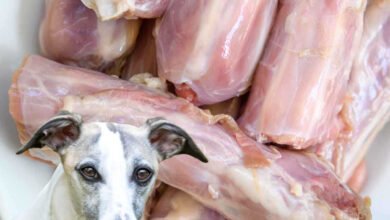
Can Dogs Eat Breadsticks? Breadsticks might seem like a simple snack, but they contain ingredients that can be problematic for dogs. Most breadsticks are made with wheat flour, which some dogs with gluten sensitivity may not tolerate. They also often have high amounts of salt, which can be harmful to dogs in large quantities.
Additionally, breadsticks usually include butter or oil, which adds fat that can upset sensitive stomachs or contribute to weight gain. Some varieties also contain seasonings like garlic, onion, or herbs, which are toxic to dogs. It’s important to consider these ingredients before sharing breadsticks with your dog.Lets discuss that- can dogs eat Breadsticks?
Are Plain Breadsticks Okay for Dogs?
Plain breadsticks, when given in moderation, can be a safe treat for your dog. However, there are some important considerations to keep in mind when offering them. It’s essential to stick to simple, unseasoned breadsticks and pay attention to portion sizes to avoid any potential health issues. Let’s dive into the key points to consider when sharing plain breadsticks with your dog.
Plain Breadsticks in Small Amounts
Plain breadsticks are generally safe for dogs, but only when given in small amounts. These breadsticks do not contain harmful additives like garlic or onion, which can be toxic to dogs. However, they are still high in carbohydrates and calories, so it’s important to limit how often they’re given to avoid weight gain or digestive issues.
- Plain breadsticks are safe in small quantities if they don’t contain any added seasonings or harmful ingredients.
- Moderation is key – breadsticks should only be an occasional treat.
Avoid Flavored Breadsticks
Flavored breadsticks, such as those with garlic, onion, cheese, or salt, should be avoided altogether. These ingredients can be toxic to dogs, leading to serious health problems. For example, garlic and onion are known to damage red blood cells in dogs, potentially causing anemia. Similarly, high salt content can lead to sodium poisoning.
- Avoid breadsticks with garlic, onion, cheese, or salt, as these ingredients can be harmful to dogs.
- Check the ingredients before offering any type of breadstick to ensure it’s free from harmful additives.
Portion Control
Even when offering plain breadsticks, portion control is important. Breadsticks can be high in calories, and consuming too many can lead to weight gain or digestive issues. A small bite or two is usually enough for a dog to enjoy the treat without overindulging.
- Give a small piece of bread stick to your dog to ensure they don’t consume too many calories or carbs.
- Avoid making breadsticks a regular snack and only offer them occasionally as a special treat.
Plain breadsticks can be a safe and enjoyable treat for your dog when given in moderation and without any harmful seasonings. Just remember to control the portion size and ensure that the breadstick is free from toxic ingredients like garlic, onion, or excessive salt. By following these guidelines, you can share a breadstick with your dog in a way that’s both fun and safe!
Health Risks of Breadsticks for Dogs
While plain breadsticks may seem like a harmless treat, there are several health risks associated with giving them to dogs, especially if consumed in large amounts. It’s important to be aware of the potential dangers, particularly due to high salt levels, excessive carbohydrates, and the fat content often found in breadsticks. Let’s break down the main health risks associated with breadsticks for dogs.
High Salt Levels
One of the main concerns with breadsticks is their salt content. While plain breadsticks might not be heavily salted, many commercially available varieties contain added salt, which can be harmful to dogs. Excessive salt intake can lead to dehydration, increased thirst, and sodium toxicity, which can cause serious health problems like kidney damage and high blood pressure.
- Sodium toxicity: Too much salt can cause a dangerous imbalance in your dog’s electrolytes, leading to dehydration and other health complications.
- Signs of overconsumption: If your dog consumes too much salt, they may experience symptoms such as excessive thirst, vomiting, and lethargy.
Excess Carbs
Breadsticks are often high in carbohydrates, which can contribute to weight gain and obesity if fed too often. While carbs are a part of a dog’s balanced diet, too many can lead to unhealthy weight gain, especially if your dog is not getting enough exercise to burn off those calories.
- Weight gain: Consuming breadsticks too frequently can add extra calories to your dog’s diet, leading to obesity.
- Health risks: Obesity can lead to other serious conditions like diabetes, joint problems, and heart disease.
Fat Content
Many breadsticks are made with butter, oil, or other fatty ingredients to enhance flavor. These fats, while providing taste, can also cause digestive upset in dogs. In severe cases, excessive fat consumption can lead to pancreatitis, a painful and potentially life-threatening condition.
- Digestive issues: High-fat content can cause stomach upset, including vomiting, diarrhea, or bloating.
- Pancreatitis: If your dog consumes too much fat, especially over time, it can lead to inflammation of the pancreas, which can be dangerous.
Breadsticks can pose several health risks to dogs, including excessive salt, high carbohydrate content, and unhealthy fats. These factors can lead to dehydration, weight gain, and digestive problems, so it’s important to offer them in moderation. If you’re unsure about how many breadsticks are safe for your dog, it’s best to consult with your vet to avoid potential health issues.
Signs of a Negative Reaction After Eating Breadsticks
If your dog has eaten breadsticks, it’s important to monitor them for any signs of a negative reaction. While a small amount of plain, unsalted breadstick may not cause harm, there are several symptoms to watch out for that could indicate your dog has consumed too much or is sensitive to certain ingredients. Here are the common signs that your dog may be experiencing a negative reaction after eating breadsticks.
Upset Stomach
One of the most common signs that your dog is reacting negatively to breadsticks is digestive upset. The ingredients in breadsticks, particularly fat, salt, and spices, can irritate your dog’s stomach and cause discomfort. This may lead to vomiting, diarrhea, or excessive gas.
- Vomiting: If your dog vomits after eating breadsticks, it could be a sign of a food intolerance or an upset stomach caused by high-fat or high-salt content.
- Diarrhea: Loose stools or diarrhea are another sign that your dog’s digestive system didn’t tolerate the breadstick well.
- Gas: Excess gas or bloating may indicate that the breadstick has caused stomach irritation.
Excessive Thirst
If your dog drinks a lot more water than usual after eating breadsticks, it could be a sign that they’ve consumed too much salt. High sodium content in the breadsticks can lead to dehydration, which may cause your dog to feel unusually thirsty.
- Signs of dehydration: If your dog’s thirst seems excessive, watch for other signs of dehydration like dry gums, lethargy, or a decrease in urination.
Fatigue or Lethargy
Another common symptom of a negative reaction to breadsticks is fatigue or lethargy. If your dog is unusually tired, weak, or unwilling to play, it could be a sign of a reaction to the salt, fat, or other ingredients in the breadstick. This might indicate that your dog’s body is struggling to process the food or cope with a potential overload of calories or fat.
- Lethargy: If your dog is typically active but becomes unusually sluggish after eating breadsticks, this could be a sign that the snack didn’t sit well with them.
- Weakness: In more severe cases, your dog may exhibit weakness or difficulty standing, which may require a vet’s attention.
After giving your dog a breadstick, it’s crucial to keep an eye out for any signs of discomfort or illness. Vomiting, diarrhea, excessive thirst, and lethargy are all red flags that your dog may have had an adverse reaction. If you notice any of these symptoms, it’s best to consult with your vet to ensure your dog’s health and well-being.
Dog-Friendly Alternatives to Breadsticks
If you’re looking for healthier alternatives to breadsticks for your dog, there are several safe and nutritious options that provide a similar crunch without the risks associated with high salt, fat, or spices. These alternatives not only offer a satisfying treat but also contribute to your dog’s overall health. Here are some great options to consider.
Vegetable Sticks
Vegetables are a great, dog-friendly alternative to breadsticks. Many vegetables are low in calories and rich in nutrients, making them a healthy choice for your dog.
- Carrots: Carrots are crunchy, naturally sweet, and high in fiber and vitamins. They can help clean your dog’s teeth and satisfy their need to chew.
- Cucumbers: Cucumbers are hydrating, low-calorie, and safe for dogs. They can be a refreshing snack, especially during hot weather.
- Celery: Celery is another low-calorie vegetable that’s full of fiber and vitamins. It’s a great option for dogs who need a crunchy treat.
Fruits
Fruits can be a delicious and safe snack for dogs, offering both flavor and hydration. Just be sure to remove seeds, pits, or cores before offering fruit to your dog.
- Apple Slices (without seeds): Apples are a low-calorie, high-fiber fruit that can help keep your dog’s digestive system healthy. Just be sure to remove the seeds, as they can be harmful.
- Watermelon Chunks: Watermelon is hydrating and packed with vitamins A and C. It’s a great option for dogs who need a refreshing treat on a hot day.
Dog-Safe Crackers
If you’re looking for a crunchy snack similar to breadsticks but specifically designed for dogs, consider dog-safe crackers. These crackers are formulated to be low in salt and fat, making them a safer option than human crackers or breadsticks.
- Low-Salt, Low-Fat Options: Many pet stores offer dog-friendly crackers made with simple ingredients, often including whole grains and vegetables. These can be a tasty and healthy treat for your dog, without the dangers of high sodium or fat.
While breadsticks may not be the best choice for your dog, there are plenty of delicious and healthy alternatives that can satisfy their snack cravings. Vegetables like carrots and cucumbers, fruits like apples and watermelon, and dog-safe crackers provide a crunchy, nutritious treat without the harmful ingredients found in breadsticks. Always remember to choose snacks that are safe for dogs and provide them in moderation.
Tips for Offering Breadsticks Safely to Dogs
If you decide to share a small bite of breadstick with your dog, it’s important to do so safely to avoid any health risks. Here are a few helpful tips to ensure that your dog enjoys the treat without any negative consequences.
Limit to Small Portions
Breadsticks should only be given in small quantities and on rare occasions. While they’re generally safe in tiny portions, offering too much at once can lead to digestive upset or contribute to weight gain due to their high carbohydrate and fat content.
- Stick to a Small Bite: A small piece, no larger than a bite-sized chunk, is all your dog needs.
- Occasional Treat: Treat breadsticks as an occasional snack, not a regular part of their diet, to avoid excess calories and sodium.
Opt for Plain Varieties
When offering breadsticks, it’s essential to stick to plain, unseasoned varieties. Many breadsticks contain ingredients like garlic, onion, cheese, or other spices that can be harmful to dogs.
- Plain and Simple: Choose breadsticks without any added seasonings, butter, or cheese to ensure they’re safe for your dog.
- Avoid Flavored Options: Breadsticks with garlic, onion, or excessive salt should be completely avoided, as these can be toxic to dogs.
Monitor for Reactions
After offering a breadstick to your dog, it’s important to observe them closely for any signs of discomfort or digestive upset. Every dog reacts differently to new foods, so it’s best to be cautious.
- Watch for Symptoms: Look out for signs such as vomiting, diarrhea, or excessive thirst, which could indicate a negative reaction.
- Be Alert for Lethargy: If your dog seems unusually tired or lethargic, this could signal that they are not tolerating the breadstick well.
Conclusion
Sharing a breadstick with your dog is okay in moderation, but it’s important to offer small portions of plain varieties and monitor for any adverse reactions. Always choose simple, unseasoned breadsticks and keep them as an occasional treat to avoid potential health risks.



